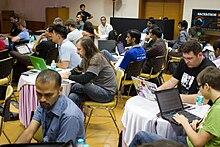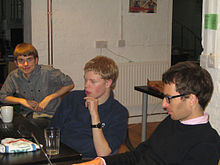Wikipedia:Wikipedia Signpost/2011-11-21/Technology report
Mumbai and Brighton hacked; horizontal lists have got class
Mumbai, Brighton Hackathons

Two hackathons were held simultaneously over the weekend, one in Mumbai, India, and another in the British seaside town of Brighton. The former was designed to coincide with WikiConference India, a major meetup for editors interested in the expansion in Wikimedia's presence in India (see "In the news").
The Mumbai Hackathon featured work on the Narayam extension, allowing editors to work with non-Latin scripts more easily within MediaWiki. The WebFonts extension, set to be deployed to several wikis on 12 December and aimed at eliminating the "square box" character phenomenon by taking advantage of the latest web technologies, was also tested. Unfortunately, the typeface used for a number of Indic scripts was found to be lacking for certain characters, prompting a number of bug reports to be sent to its maintainer Red Hat.

Mumbai also saw work on the Kiwix reader, India-MobileFrontend tie-ins and, more broadly, the hackathon helped to share knowledge among the large number of potential developers and contributors at the event. Overall, internationalisation team member Gerard Meijssen was led to comment that "the [India] hackathon proved as always that when you bring great people together special things can and do happen." Among others, the hackathon was attended by WMF Volunteer Development Co-ordinator Sumana Harihareswara and staff developers Brandon Harris, Tomasz Finc and Patrick Reilly.
The smaller Brighton Hackathon had fewer participants, with work on creating a standalone version of MediaWiki within the Vagrant framework and on bugsmashing (approximately 25 bugs were resolved), among other projects. In attendance were staff developers Roan Kattouw, Antoine Musso and Sam Reed, along with a number of other volunteer developers, Wikimedians and members of the wider free culture movement (notes from Saturday, notes from Sunday).
Horizontal lists have got class
In March 2007, a method for having horizontal lists – especially those in navboxes – rendered as proper, semantically-correct, standards-compliant and more accessible HTML lists was proposed by Andy Mabbett. The following month, he created the {{flatlist}} template for this purpose. In those days, however, support for the necessary CSS styling was severely lacking in some browsers. In March this year, Andy again asked for help to resolve the outstanding issues, but poor CSS support in older Microsoft browsers was still a problem. Despite this, editors increasingly began to add the flatlist template to navboxes.
This November, discussion resumed, prompting Erwin Dokter to do a complete overhaul, using CSS that is supported by all modern browsers, along with a few lines of JavaScript to extend support to older browsers, to achieve horizontal lists without recourse to the previous method of using resource-hungry templates such as {{nowrap}} and {{•}}. This method quickly gained the consensus needed to roll out the revised format for horizontal lists en masse. Currently, several editors are in the process of converting navboxes to use the new hlist class, replacing most inline templates. A bot to complete the task has also been requested.
The advantages extend to both readers and editors. In addition to easier editing of navboxes and speedier page-load times, users of screen readers will no longer hear the confusing sequence "one dot two dot three dot..." and instead hear just the list items. Any type of list is permitted, and nested lists are also supported. For more details, see WP:HLIST.
In brief
Not all fixes may have gone live to WMF sites at the time of writing; some may not be scheduled to go live for many weeks.
- Page text storage centralised onto dedicated servers: "The Technical Operations team has just completed behind-the-scenes work that will likely never be noticed by our readers." So began a post this week on the Wikimedia blog. That work related to moving away from a mishmash where revision text was stored on many different servers (sometimes with conflicts between them) and towards a configuration of eight dedicated page text servers. The work improves page load time slightly in some cases, but, for the most part makes the configuration much more reliable and easier to maintain in future.
- MediaWiki 1.18.0rc1: The first release candidate for MediaWiki 1.18 was released on 17 November (wikitech-l mailing list). Release candidates normally signify the "beginning of the end" of the release cycle, with a full release to external sites expected imminently. In related news, code review statistics for MediaWiki 1.19 are now available, though they appear to show an unexpectedly large backlog of revisions needing to be checked before 1.19 can be deployed to Wikimedia wikis (also wikitech-l).
- Can an app store cope?: Gerard Meijssen used a post on his personal blog to muse on whether or not app stores were designed to cope with programs likely to change as regularly as translatewiki.net supported ones, which can be updated with new translations as regularly as every day. Virtually all app stores operate a heavy scrutiny app pre-review process for all new apps and, crucially, updates to those apps.
- TL;DR: WMF Director of Platform Engineering, Rob Lanphier, posted on the Wikimedia blog about the Technical Liaison; Developer Relations (TL;DR) team at the Foundation. "While everyone in Engineering is responsible for those things to some extent, the team helps fortify our commitment to this" wrote Lanphier. According to the post, the grouping current consists of three staff all well known to Signpost readers: Volunteer Development Co-ordinator Sumana Harihareswara, bugmeister Mark Hershberger, and Technical Communications Manager Guillaume Paumier – who writes (among other things) the WMF's monthly engineering reports. As Lanphier also admitted, one incentive to blog was "because we’re hiring, and we (still) want to get the word out [about that]". In unrelated news, the analytics team blogged about the tools currently available for supporting volunteers analysts and researchers.
- New Wikimedia map-pack released: Data analyst Erik Zachte reported this week how he had recently made two new maps of Wikimedian activity available on the stats.wikimedia.org site. The two maps (number 4 and 5 on the display) illustrate page view distribution and mobile penetration respectively.



Discuss this story